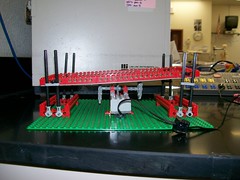Attending
BLC07 has been an inspirational experience for me. I have always "known" about the various collaboration tools available on the internet. What I haven't been able to wrap my brain around is how to apply these methods of communication in my classroom. I started BLC07 attending a workshop by
Will Richardson. In his workshop he reviewed technologies such as RSS, blogs, and wikis most of which I was already familiar with. Even though we spent a lot of time reviewing technical skills, he really drove home the idea the connections we make are what is important.
Alan November again repeated this same concept in another session that I attended. In education we need to connect our students to not only each other, but to others in the world. When we make connections and build our own personal networks that is when the real learning starts to occur.
What makes web 2.0 so powerful is that we can connect our students to people they may have never had a chance to connect to before. It could be an author, researcher, athlete, or anyone. When a student makes a connection to an author of a book they are reading that is really empowering for that student. Other connections that are important are that between the teacher, parent, and student. As
Dr. Tim Tyson points out in his presentations the blog can help connect the parent to the classroom. Connecting the parents and family to the classroom is very important to the students education.
I am just beginning to connect myself to the world and I hope to start to help my students connect to the world as well.



